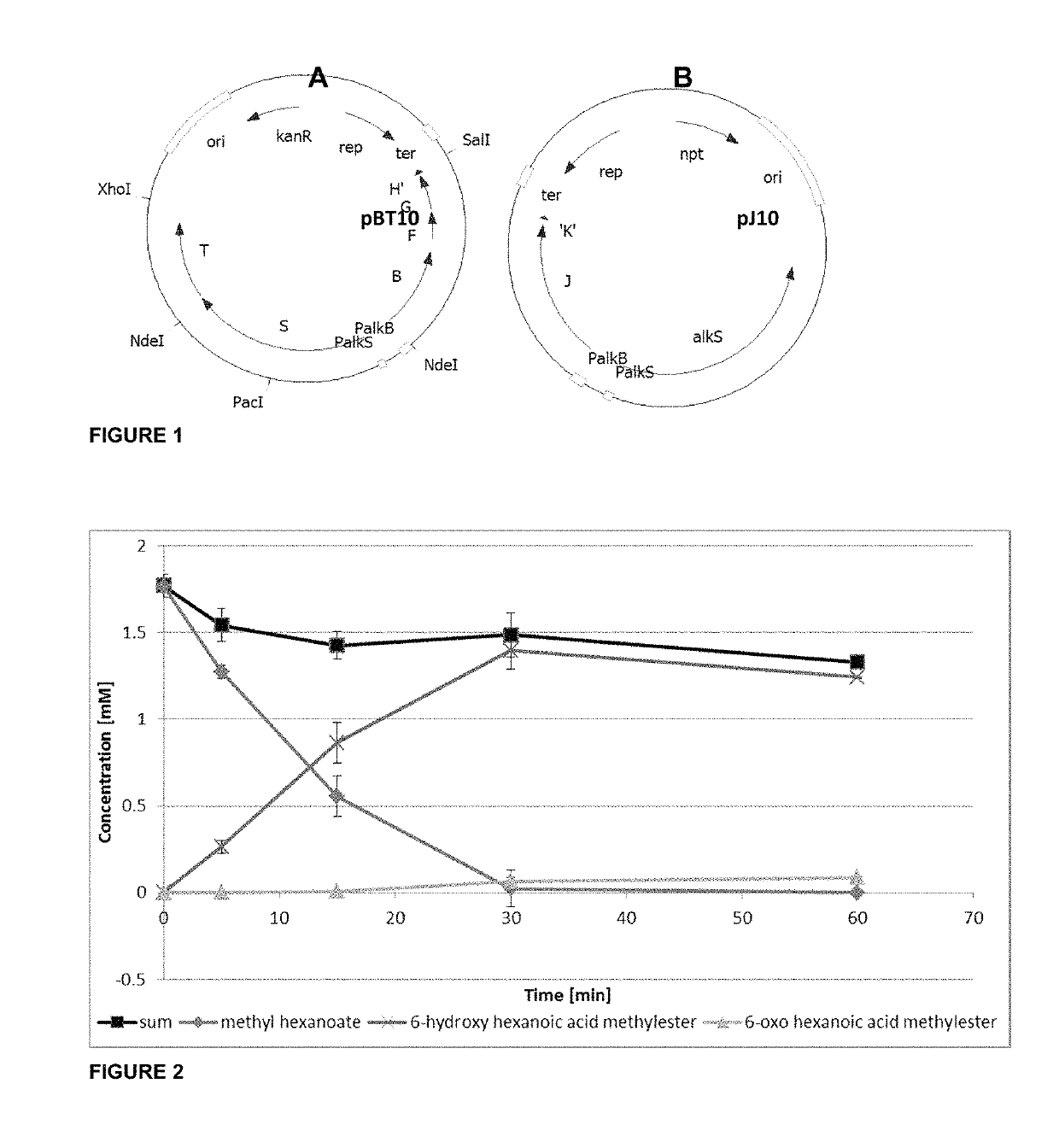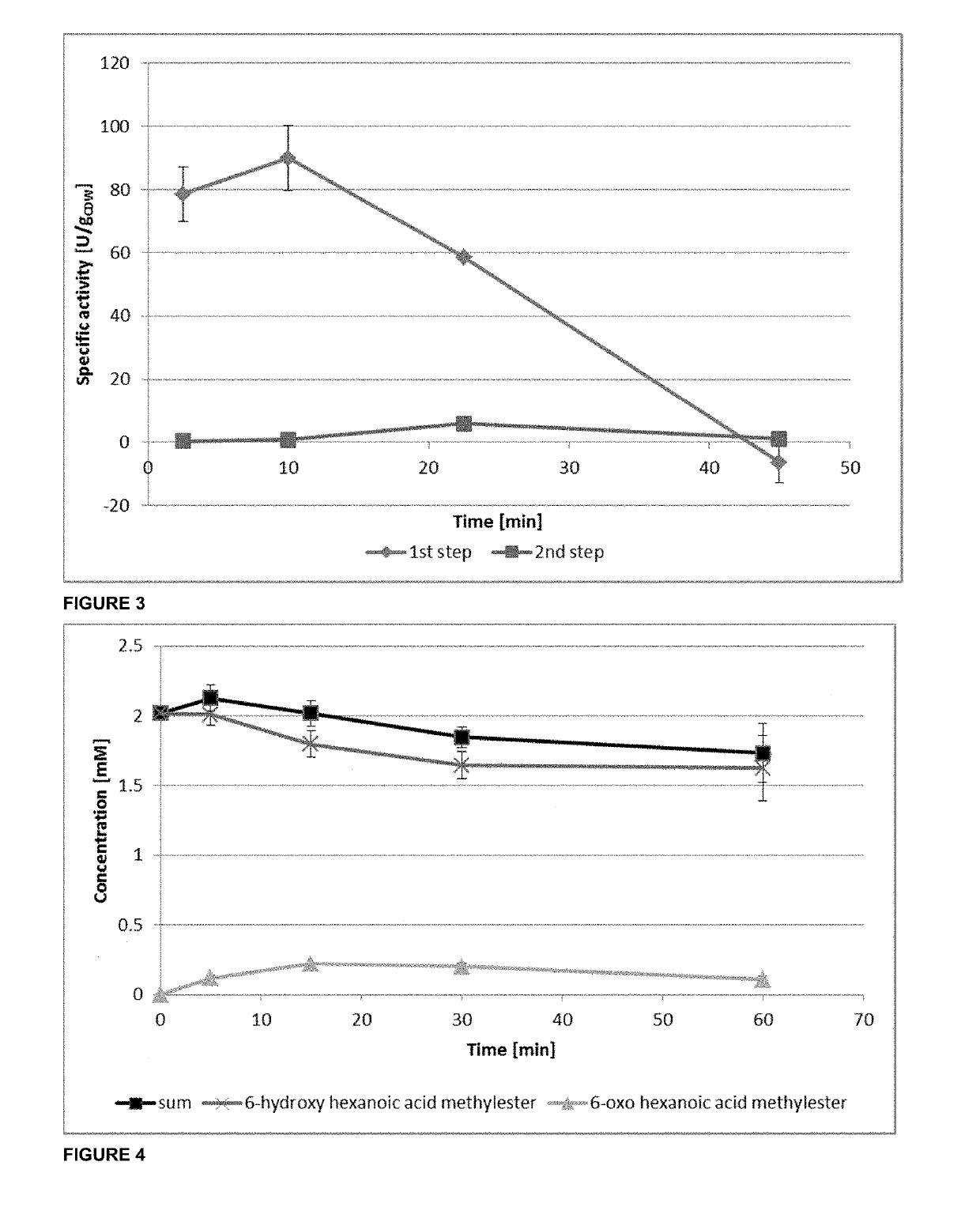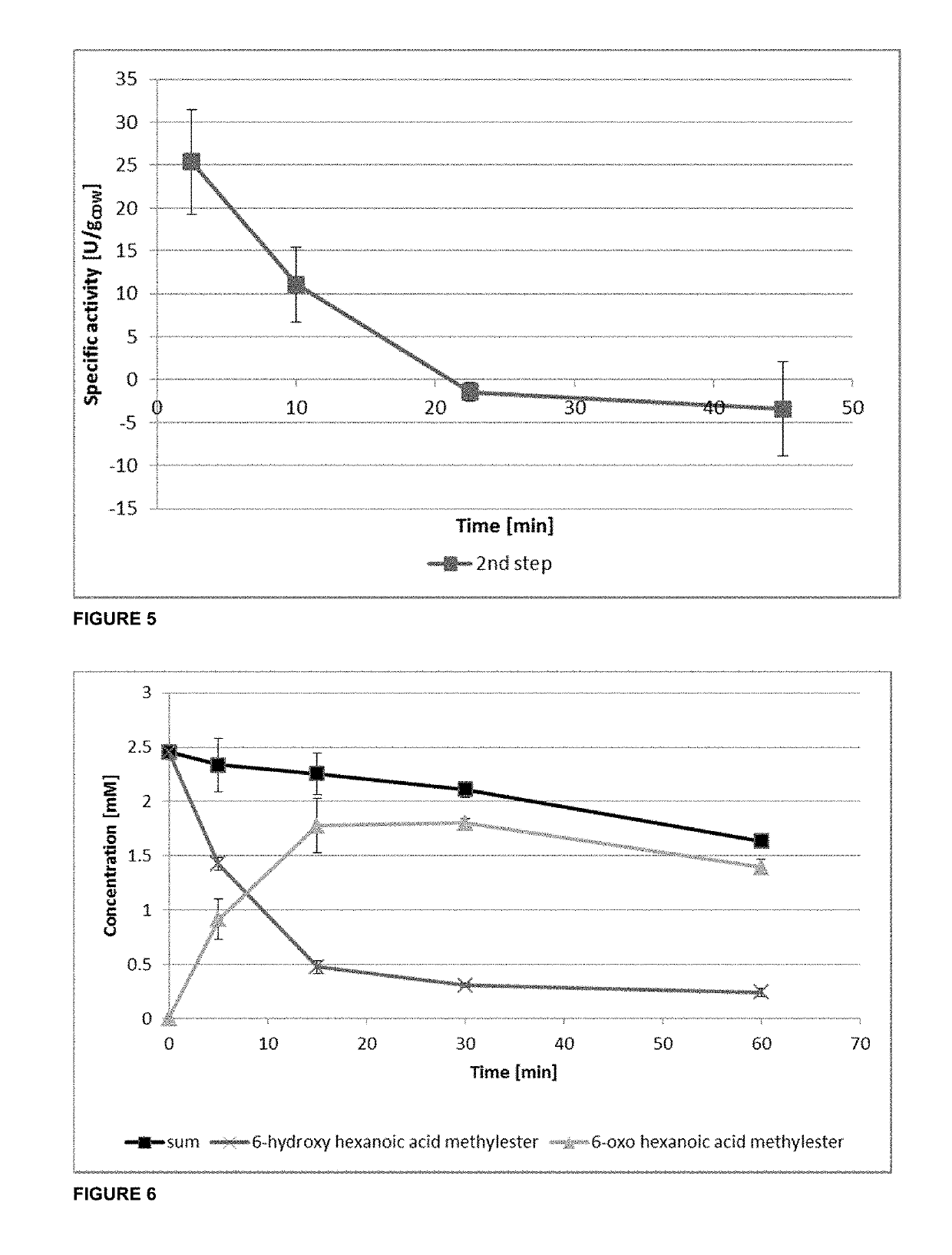Method of producing nylon
a technology of nylon and cyclizing hydrolysis, which is applied in the direction of enzymology, biochemistry apparatus and processes, transferases, etc., can solve the problems of large amounts of salts, sodium sulphate, and by-products, and achieve the effect of facilitating purification of the target produ
- Summary
- Abstract
- Description
- Claims
- Application Information
AI Technical Summary
Benefits of technology
Problems solved by technology
Method used
Image
Examples
example 1
[0128]Production of Ethanol and Acetate from Synthesis Gas
[0129]For the biotransformation of synthesis gas (66% H2, 33% CO2) to ethanol and acetate, the bacterium Clostridium ljungdahlii was used. All cultivation steps were carried out under anaerobic conditions in pressure-resistant glass bottles that can be closed airtight with a butyl rubber stopper.
[0130]For the cell culture of C. ljungdahlii 5 mL cryoculture was grown anaerobically in 50 ml of ATCC1754 medium (ATCC1754 medium: pH 6.0, 20 g / L MES, 1 g / L yeast extract, 0.8 g / L NaCl, 1 g / L NH4Cl, 0.1 g / L KCl, 0.1 g / L KH2PO4, 0.2 g / L MgSO4.7H2O, 0.02 g / L CaCl2x2H2O, 20 mg / L nitrilotriacetic acid, 10 mg / L MnSO4xH2O, 8 mg / L (NH4)2Fe(SO4)2x6H2O, 2 mg / L CoCl2x6H2O, 2 mg / L ZnSO4.7H2O, 0.2 mg / L CuCl2x2H2O, 0.2 mg / L Na2MoO4x2H2O, 0.2 mg / L NiCl2x6H2O, 0.2 mg / L Na2SeO4, 0.2 mg / L Na2WO4x2H2O, 20 g / L d-biotin; 20 μg / L folic acid, 100 μg / L pyridoxine HCl, 50 g / L thiamine-HClxH2O, 50 g / L riboflavin, 50 g / L nicotinic acid, 50 g / L calcium pantoth...
example 2
[0132]Production of Butyric and Hexanoic Acid from Synthesis Gas
[0133]For the biotransformation of synthesis gas to butyric acid and hexanoic acid, a ω-culture of Clostridium ljungdahlii and Clostridium kluyveri was used in the production phase. The bacterium Clostridium ljungdahlii converted the H2 and CO2 from the ambient atmosphere to acetate and ethanol. These products were taken up by from the aqueous phase and converted into butyric acid and hexanoic acid by the Clostridium kluyveri.
[0134]All cultivation steps were carried out under anaerobic conditions in pressure-resistant glass bottles that can be closed airtight with a butyl rubber stopper.
[0135]For the cell culture of C. ljungdahlii 10 mL cryoculture was grown anaerobically in 100 ml of ATCC1754 medium (ATCC1754 medium: pH 6.0, 20 g / L MES, 1 g / L yeast extract, 0.8 g / L NaCl, 1 g / L NH4Cl, 0.1 g / L KCl, 0.1 g / L KH2PO4, 0.2 g / L MgSO4.7H2O, 0.02 g / L CaCl2x2H2O, 20 mg / L nitrilotriacetic acid, 10 mg / L MnSO4xH2O, 8 mg / L (NH4)2Fe(...
example 3
[0140]Production of Hexanoic Acid and Butyric Acid from Ethanol and Acetate
[0141]For the biotransformation of ethanol and acetate to hexanoic acid and butyric acid the bacterium Clostridium kluyveri was used. All cultivation steps were carried out under anaerobic conditions in pressure-resistant glass bottles that can be closed airtight with a butyl rubber stopper.
[0142]A cyroculture of Clostridium in 5 ml of DMSZ52 medium (DSMZ52 medium: pH=6.98, 10 g / L CH3COOK, 0.31 g / L K2HPO4, 0.23 g / L KH2PO4, 0.25 g / l NH4Cl, 0.20 g / l MgSO4x7 H2O, 1 g / L yeast extract, 0.50 mg / L resazurin, 10 μl / l HCl (25%, 7.7 M), 1.5 mg / L FeCl2x4H2O, 70 μg / L ZnCl2x7H2O, 100 μg / L MnCl2x4H2O, 6 μg / L H3BO3, 190 μg / L COCl2x6H2O, 2 μg / L CuCl2x6H2O, 24 μg / L NiCl2x6H2O, 36 μg / L Na2MO4x2H2O, 0.5 mg / L NaOH, 3 μg / L Na2SeO3x5H2O, 4 μg / L Na2WO4x2H2O, 100 g / L vitamin B12, 80 g / L p-aminobenzoic acid, 20 g / L D(+) Biotin, 200 μg / L nicotinic acid, 100 μg / L D-Ca-pantothenate, 300 μg / L pyridoxine hydrochloride, 200 μl / L thiamine —...
PUM
| Property | Measurement | Unit |
|---|---|---|
| time | aaaaa | aaaaa |
| time | aaaaa | aaaaa |
| time | aaaaa | aaaaa |
Abstract
Description
Claims
Application Information
 Login to View More
Login to View More - R&D
- Intellectual Property
- Life Sciences
- Materials
- Tech Scout
- Unparalleled Data Quality
- Higher Quality Content
- 60% Fewer Hallucinations
Browse by: Latest US Patents, China's latest patents, Technical Efficacy Thesaurus, Application Domain, Technology Topic, Popular Technical Reports.
© 2025 PatSnap. All rights reserved.Legal|Privacy policy|Modern Slavery Act Transparency Statement|Sitemap|About US| Contact US: help@patsnap.com



